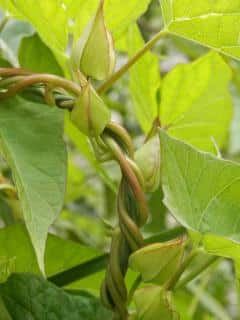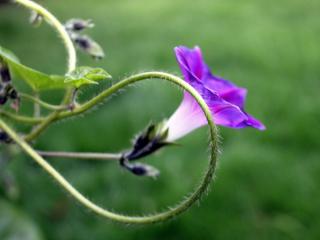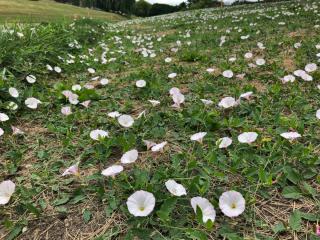

Like quackgrass, field bindweed (Convolvulus arvensis) and hedge bindweed (Calystegia sepium) belong to this category of weeds that are hard to get rid of. Vigorous and fast-growing, bindweed winds and twines around plant stems, climbs up fences, creeps along the ground in vegetable gardens… And it teases the gardener with its pure white or pink flowers!
To go further:
Some will tell you that bindweed has a certain charm with its pure white or pink flowers and its twining stems that twist around anything that happens to be nearby. Ephemeral, single-day flowers, very melliferous feed bees, bumblebees, and hoverflies, which are very useful in vegetable gardens for pollination.

Bindweed is a creeping perennial that is part of the Convolvulaceae family, with deciduous foliage. It has a network of underground rhizomes that resists cold weather very well. In winter, foliage dies off but the plant, underground, lies dormant. In spring, it resurfaces, more vigorous than ever before!
Bindweed usually grows in compacted soils that have high levels of nitrogen. It is therefore considered a bio-indicator plant, useful when trying to identify the soil in a given location.
Bindweed has deep roots that easily spread thanks to buds that give new shoots. In addition, seeds scatter by wind, overcoming every obstacle. It’s safe to say that the soil of your flower beds, borders or vegetable garden can quickly get overrun with this weed.

Several methods are available:
 Pull it out with a spading fork or a broadfork, also known as a grelinette, to tease roots out of the ground by lifting the soil. Don’t go too fast to avoid breaking the roots. You’ll likely need to repeat this, at the end of winter’s, for several years!
Pull it out with a spading fork or a broadfork, also known as a grelinette, to tease roots out of the ground by lifting the soil. Don’t go too fast to avoid breaking the roots. You’ll likely need to repeat this, at the end of winter’s, for several years!Natural tip to contain bindweed: you can let it grow along a fence or post inside your chicken coop, mixed with morning glories (Ipomoea indica). Morning glory is a non-invasive bindweed variety with large blue flowers. Chickens will peck off any shoots that try to spread out from that little island in the center. They’ll also eat up most of the seeds that fall to the ground. The melliferous flowers will attract insects for the chickens to feed on all summer long, and stems coiled in the mesh wire will provide shade. In fall, you just remove dry stems.